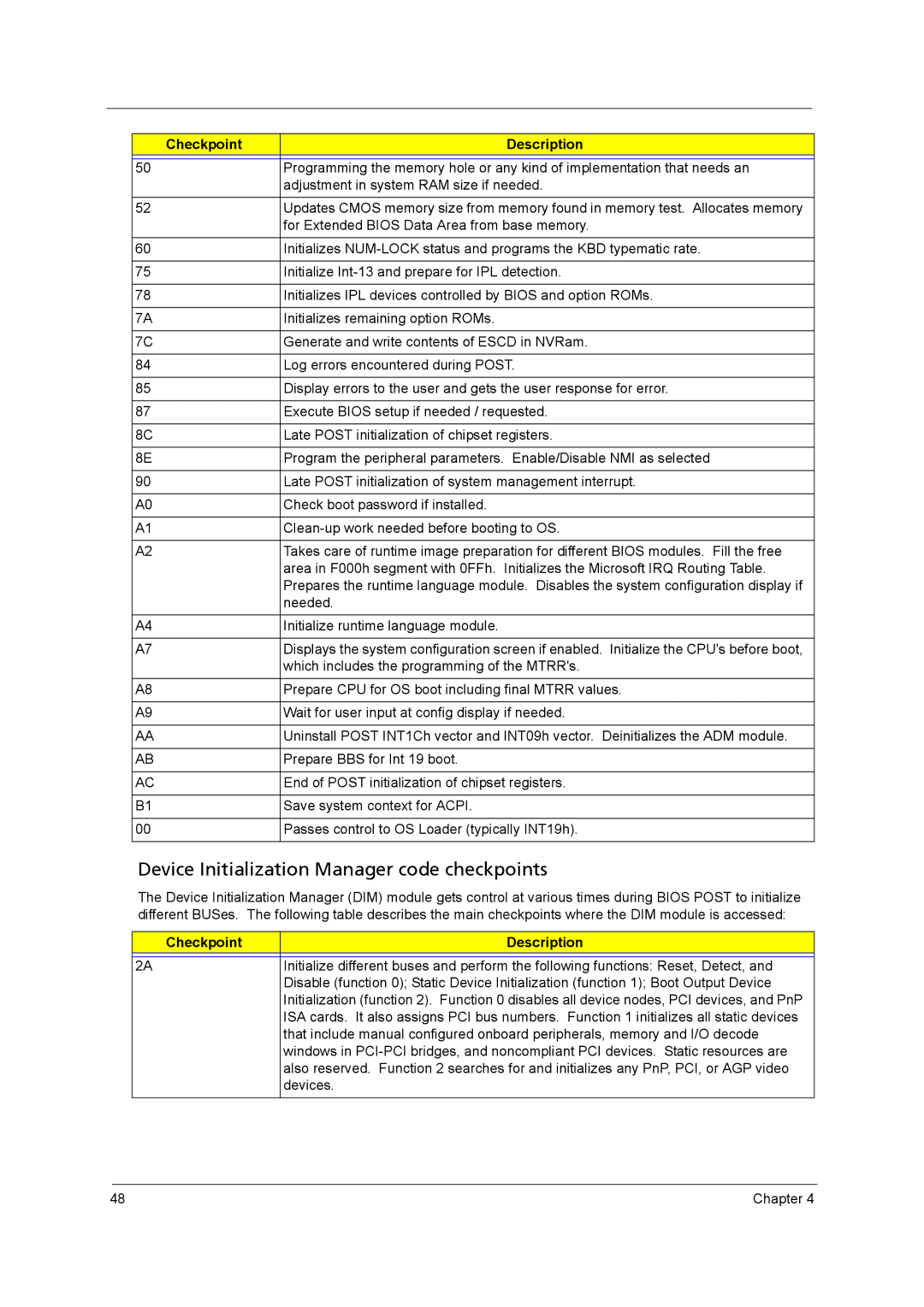
| Checkpoint | Description | |
|
|
|
|
50 | Programming the memory hole or any kind of implementation that needs an | ||
|
| adjustment in system RAM size if needed. | |
|
| ||
52 | Updates CMOS memory size from memory found in memory test. Allocates memory | ||
|
| for Extended BIOS Data Area from base memory. | |
|
| ||
60 | Initializes | ||
|
| ||
75 | Initialize | ||
|
| ||
78 | Initializes IPL devices controlled by BIOS and option ROMs. | ||
|
|
| |
| 7A | Initializes remaining option ROMs. | |
|
|
| |
| 7C | Generate and write contents of ESCD in NVRam. | |
|
| ||
84 | Log errors encountered during POST. | ||
|
| ||
85 | Display errors to the user and gets the user response for error. | ||
|
| ||
87 | Execute BIOS setup if needed / requested. | ||
|
|
| |
| 8C | Late POST initialization of chipset registers. | |
|
|
| |
| 8E | Program the peripheral parameters. Enable/Disable NMI as selected | |
|
| ||
90 | Late POST initialization of system management interrupt. | ||
|
|
| |
| A0 | Check boot password if installed. | |
|
|
| |
| A1 | ||
|
|
| |
| A2 | Takes care of runtime image preparation for different BIOS modules. Fill the free | |
|
| area in F000h segment with 0FFh. Initializes the Microsoft IRQ Routing Table. | |
|
| Prepares the runtime language module. Disables the system configuration display if | |
|
| needed. | |
|
|
| |
| A4 | Initialize runtime language module. | |
|
|
| |
| A7 | Displays the system configuration screen if enabled. Initialize the CPU's before boot, | |
|
| which includes the programming of the MTRR's. | |
|
|
| |
| A8 | Prepare CPU for OS boot including final MTRR values. | |
|
|
| |
| A9 | Wait for user input at config display if needed. | |
|
|
| |
| AA | Uninstall POST INT1Ch vector and INT09h vector. Deinitializes the ADM module. | |
|
|
| |
| AB | Prepare BBS for Int 19 boot. | |
|
|
| |
| AC | End of POST initialization of chipset registers. | |
|
|
| |
| B1 | Save system context for ACPI. | |
|
| ||
00 | Passes control to OS Loader (typically INT19h). | ||
|
|
|
|
Device Initialization Manager code checkpoints
The Device Initialization Manager (DIM) module gets control at various times during BIOS POST to initialize different BUSes. The following table describes the main checkpoints where the DIM module is accessed:
Checkpoint | Description |
2A | Initialize different buses and perform the following functions: Reset, Detect, and |
| Disable (function 0); Static Device Initialization (function 1); Boot Output Device |
| Initialization (function 2). Function 0 disables all device nodes, PCI devices, and PnP |
| ISA cards. It also assigns PCI bus numbers. Function 1 initializes all static devices |
| that include manual configured onboard peripherals, memory and I/O decode |
| windows in |
| also reserved. Function 2 searches for and initializes any PnP, PCI, or AGP video |
| devices. |
|
|
48 | Chapter 4 |
